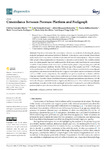Concordance between pressure platform and pedigraph

Ver/
Use este enlace para citar
http://hdl.handle.net/2183/30469
A non ser que se indique outra cousa, a licenza do ítem descríbese como Creative Commons Attribution 4.0 International License (CC-BY 4.0)
Coleccións
- Investigación (FFISIO) [503]
Metadatos
Mostrar o rexistro completo do ítemTítulo
Concordance between pressure platform and pedigraphAutor(es)
Data
2021-12-09Cita bibliográfica
Gonzalez-Martin C, Fernandez-Lopez U, Mosquera-Fernandez A, Balboa-Barreiro V, Garcia-Rodriguez MT, Seijo-Bestilleiro R, Veiga-Seijo R. Concordance between pressure platform and pedigraph. Diagnostics (Basel). 2021 Dec 9;11(12):2322.
Resumo
[Abstract] Objectives: Determine the concordance between two methods of obtaining the plantar footprint (pedigraph and pressure platform). Methods: A descriptive, cross-sectional, observational study of prevalence was carried out in the social center of Cariño (Coruña), Spain (n = 65 participants). Older people without amputations or the presence of dysmetria were included. The variables studied were: sociodemographic (age, sex), anthropometric (body mass index) and footprint measurement variables. These measurements were made by obtaining the plantar footprint using two methods: pedigraph and pressure platform. Results: The mean age of the sample was 37.42 ± 15.05 years, with a predominance of the female gender (61.54%). Positive linear correlation between pedigraph and platform was observed in both feet in the Chippaux and Staheli indices (correlation coefficient > 0.3, p < 0.001 in each comparison). The reliability was good or moderate in relation with the Chippaux and Staheli index. Slightly lower coefficients were observed in the dimensions of the foot. Conclusions: A positive linear correlation between pedigraph and platform was observed in both feet in the Chippaux and Staheli indices. Significant differences were observed between pedigraph and platform in relation to the width and length of the foot. It is probably due to the fact that the pressure platform provides more exhaustive, detailed and accurate information of the foot.
Methods: A descriptive, cross-sectional, observational study of prevalence was carried out in the social center of Cariño (Coruña), Spain (n = 65 participants). Older people without amputations or the presence of dysmetria were included. The variables studied were: sociodemographic (age, sex), anthropometric (body mass index) and footprint measurement variables. These measurements were made by obtaining the plantar footprint using two methods: pedigraph and pressure platform.
Results: The mean age of the sample was 37.42 ± 15.05 years, with a predominance of the female gender (61.54%). Positive linear correlation between pedigraph and platform was observed in both feet in the Chippaux and Staheli indices (correlation coefficient > 0.3, p < 0.001 in each comparison). The reliability was good or moderate in relation with the Chippaux and Staheli index. Slightly lower coefficients were observed in the dimensions of the foot.
Conclusions: A positive linear correlation between pedigraph and platform was observed in both feet in the Chippaux and Staheli indices. Significant differences were observed between pedigraph and platform in relation to the width and length of the foot. It is probably due to the fact that the pressure platform provides more exhaustive, detailed and accurate information of the foot.
Palabras chave
Foot
Pedigragh
Pressure platform
Pedigragh
Pressure platform
Versión do editor
Dereitos
Creative Commons Attribution 4.0 International License (CC-BY 4.0)
ISSN
2075-4418






